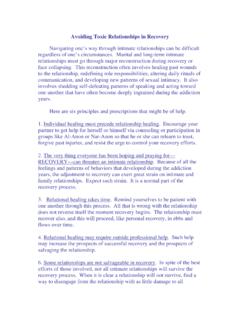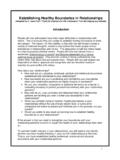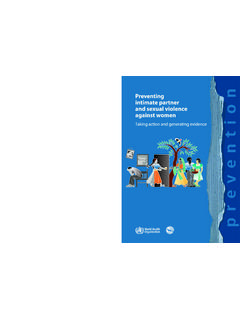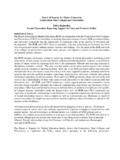Transcription of Primary prevention of intimate-partner violence and sexual ...
1 Primary prevention of intimate - partner violence and sexual violence : Background paper for WHO expert meeting May 2 3, 2007 A. Harvey,1 C. Garcia-Moreno2 and A. Butchart1 1 WHO, Department of violence and Injury prevention and Disability 2 WHO, Department of Reproductive Health and Research The designations employed and the presentation of the material in this publication do not imply the expression of any opinion whatsoever on the part of the World Health Organization concerning the legal status of any country, territory, city or area or of its authorities, or concerning the delimitation of its frontiers or boundaries.
2 Dotted lines on maps represent approximate border lines for which there may not yet be full agreement. The mention of specific companies or of certain manufacturers products does not imply that they are endorsed or recommended by the World Health Organization in preference to others of a similar nature that are not mentioned. Errors and omissions excepted, the names of proprietary products are distinguished by initial capital letters. All reasonable precautions have been taken by the World Health Organization to verify the information contained in this publication. However, the published material is being distributed without warranty of any kind, either expressed or implied.
3 The responsibility for the interpretation and use of the material lies with the reader. In no event shall the World Health Organization be liable for damages arising from its use. This publication does not necessarily represent the decisions or stated policy of the World Health Organization. 2 Contents 1. Introduction 3 What do we mean by Primary prevention ? 5 A global picture of intimate - partner violence and sexual violence prevention 6 2. Primary prevention framework 7 Problem definition and measurement 8 Risk factors 8 Design, evaluate and implement proven strategies 10 3.
4 Primary prevention approaches 10 Early childhood and family-based approaches 11 School-based approaches 12 Interventions to reduce alcohol and substance misuse 15 Public information and awareness campaigns 16 Community-based prevention 18 Structural and policy approaches 21 Working with men and boys 24 Key elements for successful prevention programmes 27 4.
5 Conclusion 29 References 31 Annex 36 3 1. Introduction For more than a decade intimate - partner violence and sexual violence against women have been recognized as major global public health problems, as well as serious human rights abuses. The impact of these forms of violence on acute and long-term health and well-being has been documented in publications such as WHO s World report on violence and health (Krug et al., 2002), the WHO Multi-country study on women s health and domestic violence against women (Garcia-Moreno et al.)
6 , 2005), and various other population-based studies. intimate - partner violence and sexual violence have a damaging impact on physical, mental and reproductive and sexual health, with consequences such as physical injuries, depression, post-traumatic stress disorder, suicide attempts, substance abuse, unwanted pregnancy, gynaecological disorders, sexually transmitted infections, increased HIV/AIDS risk, and others. intimate - partner violence , sometimes called domestic violence or spouse abuse, includes acts of physical aggression, sexual coercion, psychological/emotional abuse and controlling behaviours by a current or former partner or spouse (Heise & Garcia-Moreno, 2002).
7 It can happen within marriage, long-term partnerships or short-term intimate relationships, and can be perpetrated by ex-partners when these relationships have ended. It has been documented as largely perpetrated by men against women, although such violence also occurs in same-sex couples and can be perpetrated by women against men. As a category of interpersonal violence , intimate - partner violence includes dating violence that occurs among young people, although the pattern of such violence may be different to that experienced in the context of long-term partnerships, and studies often examine the two issues separately.
8 sexual violence occurs both within intimate partnerships and outside them. It has a significant impact on both girls and boys, although among adults women are at substantially greater risk of victimization than men. Sexually violent acts can be perpetrated by intimate partners, family members, friends, acquaintances, authority figures such as teachers or clergy, or strangers. In most communities however intimate partners and people known to the victim are by far the most common category of perpetrator. sexual violence takes different forms over the lifecourse, from child sexual abuse to forced sexual initiation to sexual coercion within and outside intimate relationships.
9 Box 1. Definitions from the World report on violence and health intimate partner violence : Any behaviour within an intimate relationship that causes physical, psychological or sexual harm to those in the relationship. sexual violence : any sexual act, attempt to obtain a sexual act, unwanted sexual comments or advances, or acts to traffic, or otherwise directed, against a person's sexuality, using coercion, threats of harm or physical force, by any person regardless of relationship to the victim, in any setting, including but not limited to home and work. Source: Heise & Garcia-Moreno, 2002; Jewkes et al.
10 , 2002 4 There is no estimate of the global prevalence of either intimate - partner violence or sexual violence . Estimates vary by country, and according to study methodology ( how these types of violence are measured), and which behaviours or experiences are included in the prevalence estimate. For example, estimates of the prevalence of intimate - partner violence based on physical abuse alone, miss important dimensions of intimate partner violence , and thus are lower than estimates that also include sexual and psychological abuse (Garcia-Moreno et al., 2005). Population-based studies from various countries indicate that between 10% and 69% of women report that an intimate partner has physically abused them at least once in their lifetime (Heise et al.)

















